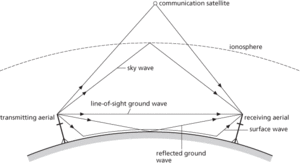The transmission of radio waves from a transmitting aerial to a receiving aerial. The radiation may take several paths. The sum of the line-of-sight ground wave, the reflected ground wave, and the surface wave is called the ground wave (or tropospheric wave). Sky waves (or ionospheric waves) are reflected by the ionosphere (see earth’s atmosphere) and enable long-distance transmissions to be made. The ionization of atoms and molecules in the ionosphere is caused largely by solar ultraviolet and X-radiation and therefore conditions differ between night and day. Ionization in the lower E-region of the ionosphere falls off at night in the absence of sunlight and ions and electrons tend to recombine. However, in the less dense (higher) F-region there are fewer collisions between ions and electrons and therefore fewer recombinations at night. The F-region is therefore a more effective reflector at night.

Radio transmission.
The UHF and VHF waves used in television broadcasting penetrate the ionosphere with little reflection. Therefore TV broadcasts can only be made over long distances by means of artificial satellites. See also radio.
- big data
- Big Dipper
- big endian
- big-endian
- big four
- Big Mac index
- big O notation
- big push
- Big Society
- Bihar
- biholomorphic
- Bijapur
- bijection
- Bikini Atoll
- Biko, Steve (1946–77)
- bilateral monopoly
- bilateral network
- bilateral shift
- bilateral symmetry
- bilateral trade
- bilateral transducer
- Bilateria
- bile
- bile duct
- bilevel resist